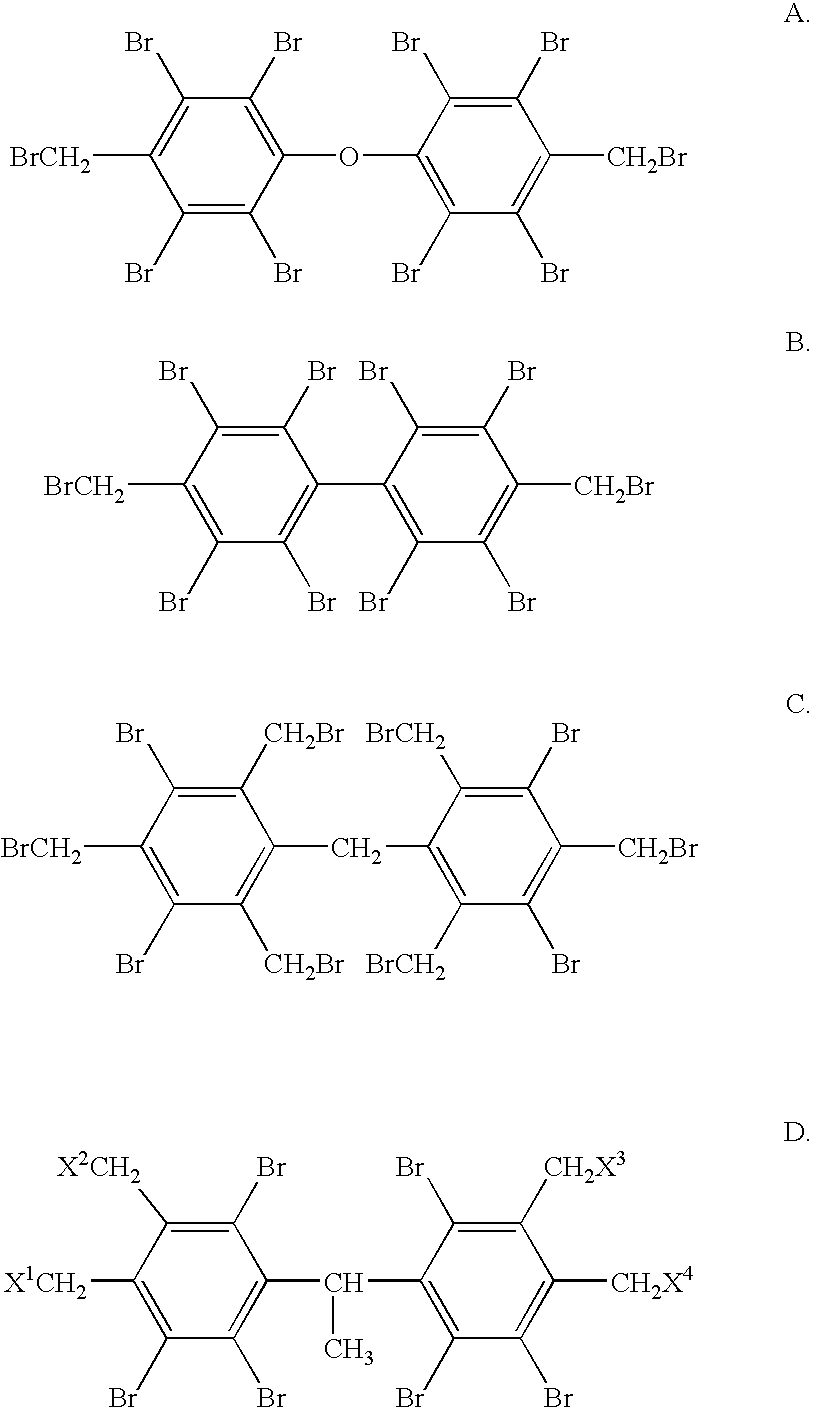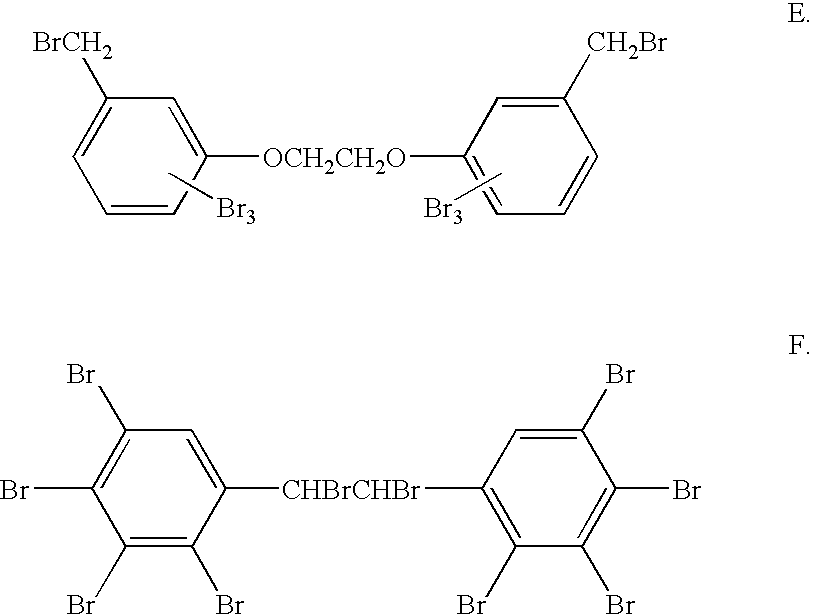Flame retardant bromobenzyl systems
a bromobenzyl and flame retardant technology, applied in the field of imparting flame retardant properties to styrene polymers, can solve the problems of metal equipment corrosion, adversely affecting the physical properties of foamed polymer products,
- Summary
- Abstract
- Description
- Claims
- Application Information
AI Technical Summary
Benefits of technology
Problems solved by technology
Method used
Image
Examples
example 1
Preparation of the Compound of Formula A
[0040]A 1 liter jacketed reactor, equipped with a mechanical stirrer, a thermocouple and a reflux condenser, was charged with a solvent mixture of dichloromethane, bromochloromethane and dibromomethane (20:40:40 wt., 500 g), AlCl3 (5 g) and p-tolyl ether (50 g). The temperature was set at 20° C., then bromine (350 g) was fed in via a peristaltic pump at a rate of 3 g / min. A post-reaction of 2.5 hours at reflux brought the reaction to completion (confirmed by GC analysis).
[0041]Work-up and isolation of the crude octabromodimethyldiphenyl ether was performed by adding water (100 g) and aq. 17% hydrazine (30 g) to the reaction mixture for catalyst destruction and reduction of excess bromine. The aqueous layer was separated. The organic slurry was mixed with water (100 g), filtered, and washed with solvent mixture (57 g) and water (100 g).
[0042]After vacuum drying there was obtained 196 g of octabromo-dimethyldiphenyl ether (93% of the theoretical...
example 2
Preparation of the Compound of Formula B
[0045]A 0.5 liter jacketed reactor, equipped with a mechanical stirrer, a thermocouple and a reflux condenser, was charged with a solvent mixture of dichloromethane, bromochloromethane and dibromomethane (20:40:40 wt., 150 g), AlCl3 (2 g) and 4,4′-dimethylbiphenyl (9.1 g). The temperature was set at 25° C., and then bromine (70 g) was fed in over a period of 1.5 hour. A post-reaction of four hours at reflux brought the reaction to completion (confirmed by GC analysis).
[0046]Work-up and isolation of the crude octabromodimethylbiphenyl was performed by adding water (75 g) and aq. 17% hydrazine (8 g) to the reaction mixture for catalyst destruction and reduction of excess bromine. The aqueous layer was separated. The organic slurry was mixed with water (50 g), filtered, and washed with solvent mixture (20 g) and water (70 g).
[0047]After vacuum drying there was obtained 31.5 g of octabromodimethylbiphenyl (77% of the theoretical, based on 4,4′-dim...
example 3
Preparation of the Compound of Formula C
[0050]A 0.5 liter jacketed reactor, equipped with a mechanical stirrer, a thermocouple and a reflux condenser, was charged with a solvent mixture of dichloromethane, bromochloromethane and dibromomethane (20:40:40 wt., 100 g) and bromine (145 g). The temperature was set at 25° C., then a solution of bismesityl methane (38 g) in solvent mixture (200 g) was fed in over a period of 1.5 hours. A post-reaction of two hours at 25° C. brought the reaction to completion (confirmed by GC analysis).
[0051]Work-up and isolation of the crude bis(3,5-dibromo-2,4,6-trimethyl)methane was performed by adding water (100 g) and aq. 37% NaHSO3 (110 g) to the reaction mixture for reduction of excess bromine. The aqueous layer was separated. The organic slurry was filtered, and washed with solvent mixture (40 g) and water (55 g).
[0052]After vacuum drying there was obtained 72 g of bis(3,5-dibromo-2,4,6-trimethyl)methane (84% of the theoretical, based on bismesityl ...
PUM
| Property | Measurement | Unit |
|---|---|---|
| time | aaaaa | aaaaa |
| temperature | aaaaa | aaaaa |
| temperatures | aaaaa | aaaaa |
Abstract
Description
Claims
Application Information
 Login to View More
Login to View More - R&D
- Intellectual Property
- Life Sciences
- Materials
- Tech Scout
- Unparalleled Data Quality
- Higher Quality Content
- 60% Fewer Hallucinations
Browse by: Latest US Patents, China's latest patents, Technical Efficacy Thesaurus, Application Domain, Technology Topic, Popular Technical Reports.
© 2025 PatSnap. All rights reserved.Legal|Privacy policy|Modern Slavery Act Transparency Statement|Sitemap|About US| Contact US: help@patsnap.com



